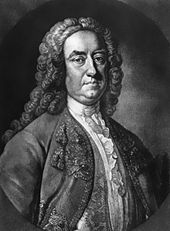Beau Nash
Richard "Beau" Nash (born October 18, 1674 in Swansea , † February 3 or 12, 1761 in Bath ) was a British dandy of the 18th century. His nickname was "King of Bath" in relation to his place of work.
Life
Nash was in 1674 in Welsh Swansea in the former Kingdom of England as a child of the upper class was born belonging to family, even though his ancestry is unclear and several options like a descent from a family in Llangwm , Pembrokeshire or the merchant Richard Nash from Carmarthen are discussed. His father was born in Pembroke and was involved in a glass factory in Swansea. Nash first visited the Carmarthen Grammar School , the Queen Elizabeth's School in Carmarthen, and from the early 1690s-years the Jesus College ofUniversity of Oxford , which he left without a degree. He then bought himself into the British Army as an officer (a common path at the time) - he served in the London Guards Division and made his first contacts with high society - but he gave up his military service in order to study law in order to later work as Barrister to work. During his studies he was known as the "authority on clothing, behavior and style". As part of the celebration of the accession of Wilhelm III. in the Inns of Court , Nash led the Middle Temple pageant . Because of his good performance in this role, he was offered the accolade , but Nash demanded an additional pension, which the king refused.
1705 Nash moved to Bath to where he shortly afterwards the Master of Ceremonies (in German master of ceremonies ascent). As such, he was responsible for the organization and implementation of various social events in the spa. In his office, Nash implemented various reforms and measures; so he improved the cityscape of Bath and reformed the social rules of the city. As a result, Bath gradually transformed into a sophisticated, affluent spa. Nash himself endeavored to appear pompous, calling himself the "King of Bath". He also indulged a life as a bachelor , but had at least two lovers. He financed his livelihood in part through gambling , an option that disappeared after gambling was banned. Nash tried in vain to challenge the relevant law in court. In 1740 he therefore got into very serious financial difficulties. His old age was financed by a pension, which enabled him to continue his way of life to a large extent. After his death on February 3 or 12, 1761 (different information exists) at the age of 86, he was buried in Bath Abbey at the expense of the City of Bath .
Nash is depicted in several works of art; The National Portrait Gallery lists four portraits of him, while the British Museum has cataloged a total of ten works with Nash as the subject, including an anonymous caricature and several portraits, including one by John Faber the Younger .
literature
- Nash, Richard . In: Encyclopædia Britannica . 11th edition. tape 19 : Mun - Oddfellows . London 1911, p. 245 (English, full text [ Wikisource ]).
- Beau Nash in the Oxford Dictionary of National Biography
Individual evidence
- ↑ a b c d e f g h i j Nash, Richard . In: Encyclopædia Britannica . 11th edition. tape 19 : Mun - Oddfellows . London 1911, p. 245 (English, full text [ Wikisource ]).
- ^ A b Robert Thomas Jenkins : NASH, RICHARD ('Beau Nash'; 1674 - 1761). In: Dictionary of Welsh Biography. The National Library of Wales, accessed November 29, 2020 .
-
↑ a b c d e Beau Nash's Bath. BBC , accessed November 29, 2020 . Beau Nash's Bath. BBC , accessed November 29, 2020 .
- ^ Richard ('Beau') Nash (1674-1762), Man of fashion. National Portrait Gallery , accessed November 29, 2020 .
- ↑ Richard 'Beau' Nash. British Museum , accessed November 29, 2020 .
| personal data | |
|---|---|
| SURNAME | Nash, Beau |
| ALTERNATIVE NAMES | Nash, Richard (maiden name); King of Bath (nickname) |
| SHORT DESCRIPTION | British dandy |
| DATE OF BIRTH | October 18, 1674 |
| PLACE OF BIRTH | Swansea , Wales |
| DATE OF DEATH | February 3, 1761 or February 12, 1761 |
| Place of death | Bath |

